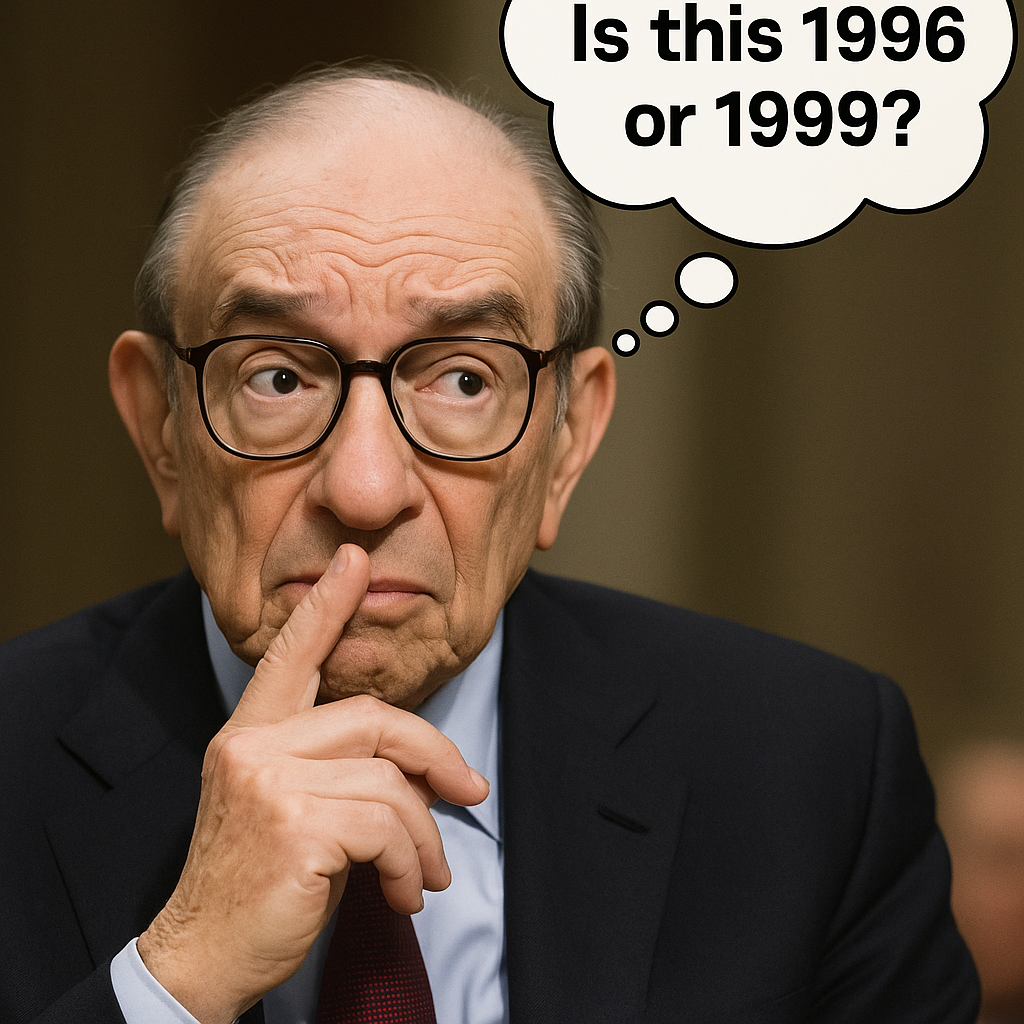Alan Greenspan’s notorious irrational exuberance speech is a traditional instance of how loopy markets can all the time get crazier.
This was the precise textual content from his speech at a coverage dinner in December of 1996:
Clearly, sustained low inflation implies much less uncertainty in regards to the future, and decrease threat premiums suggest greater costs of shares and different incomes belongings. We are able to see that within the inverse relationship exhibited by value/earnings ratios and the speed of inflation prior to now. However how do we all know when irrational exuberance has unduly escalated asset values, which then grow to be topic to sudden and extended contractions as they’ve in Japan over the previous decade? And the way can we issue that evaluation into financial coverage? We as central bankers needn’t be involved if a collapsing monetary asset bubble doesn’t threaten to impair the true economic system, its manufacturing, jobs, and value stability. Certainly, the sharp inventory market break of 1987 had few destructive penalties for the economic system. However we should always not underestimate or grow to be complacent in regards to the complexity of the interactions of asset markets and the economic system. Thus, evaluating shifts in steadiness sheets typically, and in asset costs notably, should be an integral a part of the event of financial coverage.
The previous Fed chair wasn’t pounding the desk that the inventory market was a bubble however he was actually implying one thing was afoot.
From 1980 by way of Greenspan’s speech on the tail finish of 1996, the S&P 500 was up greater than 1,200% in complete or a blistering 16.5% return on an annual foundation. Valuations had been up, up and away. The Netscape IPO occurred a yr earlier. Issues felt very toppy.
That didn’t matter. The market took off like a rocket ship following Greenspan’s speech:

From the time of Greenspan’s speech by way of the remainder of the last decade the S&P would greater than double, adequate for an annualized return of almost 26% by way of the top of 1999. The market was up 33% in 1997, 28% in 1998 and one other 21% in 1999.1
The dot-com bubble lastly burst within the spring of 2000, reducing the S&P 500 in half together with a drawdown of greater than 80% within the Nasdaq.
Some individuals are beginning to surprise if we’re in an analogous state of affairs now.

No two markets are ever the identical. The businesses within the dot-com bubble didn’t make any cash. They didn’t have the ridiculous revenue margins tech shares have right now. However there are some similarities.
The AI capex spending binge is eerily just like the telecomm buildout that occurred within the Nineteen Nineties.
Speculative exercise is in all places too — SPACs, meme shares, IPOsleverage, story shares, excessive valuations, deregulation, and so forth.
And the 2 bull markets have taken on an analogous trajectory over time:

Many individuals are attempting to determine whether or not that is the early levels of a bubble or the top of the street.
Investing can be loads simpler if there have been a easy approach to predict these kind of markets. Sadly, there’s not. Nobody can predict when human nature will take issues too far or when it would cease on a dime. The pendulum all the time swings; we simply don’t know the way far in both path.
Forecasting the market within the brief run is unattainable.
Investing for the long term is one of the best treatment for the uncertainties of the brief run.
If you happen to had invested within the S&P 500 following Greenspan’s speech in December of 1996 and held on till right now, you’ll be up simply shy of 10% per yr. You’ll have needed to dwell by way of two 50% crashes within the subsequent dozen years or so, 9/11, a number of wars, oil going to $150/barrel then destructive, the pandemic, 40-year excessive inflation, the 2022 bear market and a couple of dozen different run-of-the-mill corrections.
However even in any case that dangerous stuff you continue to would have roughly gotten the market’s long-term annual return.
That’s not dangerous.
If you happen to had invested on the peak of the market simply earlier than the dot-com bubble burst on the finish of 1999, you’ll be up a bit greater than 8% per yr. That’s not a horrible final result contemplating the entire dangerous stuff you’ll have needed to dwell by way of plus that was the most costly valuations the U.S. inventory market has ever seen.
Clearly, nobody truly invests like that (besides Bob). Individuals don’t put all of their cash to work unexpectedly.
Most individuals put money into 1996, 1999, 2007, 2009, 2020 and every little thing in-between. Top-of-the-line options of greenback price averaging into the market over time is that it permits you diversify throughout time, valuation degree and market atmosphere.
If you happen to’re averaging into the market over time you must welcome volatility.
If you happen to’re absolutely invested, you should be prepared to simply accept volatility or diversify your belongings to dampen no matter ache it might trigger.
These items are far simpler and extra useful than making an attempt to foretell the start or finish of a monetary asset bubble.
Additional Studying:
An Epic Bull Market
1And that was following +37% in 1995 and +23% in 1996. Simply an insane run.

